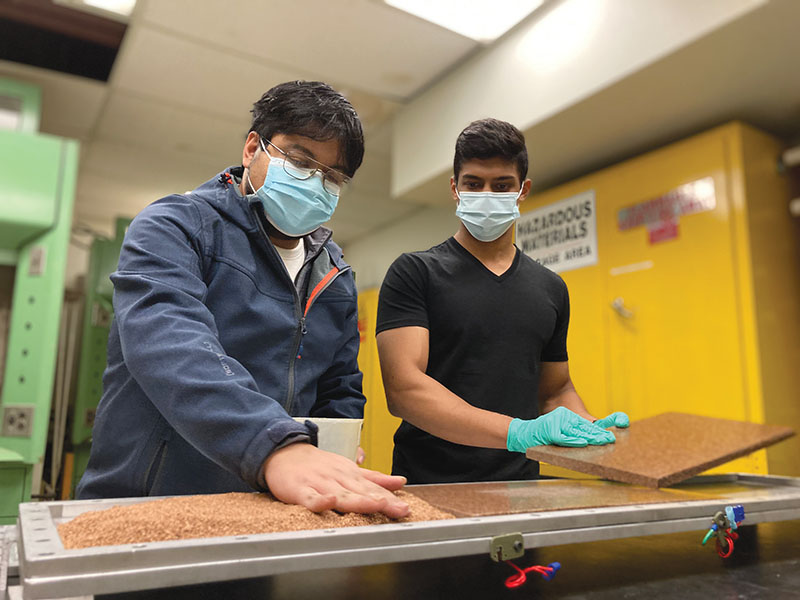
May/June 2022
The art of the upscale
The world of reusing tree nut waste is cracking wide open, and as almond hulls find their way into cattle feed and pecan shells into landscaping, hazelnut shells are being used to create decorative panels.
Using hazelnut shell waste and commercially available resin, Washington State University (WSU) is developing a panel that could be used in a variety of applications, from coffee tables to conference room walls to kitchen cabinets. Vikram Yadama, professor in the Department of Civil and Environmental Engineering and a faculty affiliate with the Composite Materials Engineering Center, is spearheading the project with Avishek Chanda, a postdoctoral researcher, and Vyasgowtham Prabhakar, a graduate student.
Skipping the traditional hot-pressing method for creating boards, the technique used with the shells involves infusing a mat of ground shells with resin. The voids within the particles are filled, creating not only a more structurally sound panel, but a more aesthetically pleasing one.
“Our goal is to maximize the amount of particles and reduce the amount of resin that is used,” said Yadama. “Resin is definitely the most expensive component of these materials, and what is currently being made uses a lot of resin.”
The craft of assembly
WSU receives already processed and cleaned nut shells, and uses a recyclable resin in a resin-transfer molding process. After determining the right atmospheric conditions for the forming process, the resin is pulled into the hazelnut shells via vacuum.
But it isn’t just about using nut waste materials to create something new. It’s also about making that new object an environmentally sensible product by using a high fiber volume fraction.

“There are a lot of companies and industries that make similar kinds of panels from other fibers,” said Chanda. “But the fiber volume fraction is less, roughly around 15-20%. Our goal is to go higher to at least 50-60% fiber volume fraction, so that there is more fiber and less resin.”
Increasing the fiber volume fraction has happened on a smaller scale, and the challenge is now in scaling up. These techniques would automatically lower the cost of production – less resin, less cost.
Included in this process is finding the balance among materials that each have their own unique mechanical properties. Particle size of the shells, their moisture content, and the method of packing them would determine the quality of the end panel.
“Nut shells are actually a pretty good waste material to use because they’re pretty clean,” said Yadama.
Hazelnut shells fall in a line of reused materials, such as wood fibers, natural fiber fabrics like those from used jute coffee bags (heavy duty burlap sacks), and sunflower hulls. Even though various materials aren’t mixed together in a single layer, there have been projects and experiments where they are layered – each material infused in resin, and then those layers assembled to construct a thicker panel. Another challenge, however, is that these resins are particularly difficult to bond to one another once the material has set.
“We wanted to demonstrate that we could bond them together using a particular technique. So, we made them separately and bonded them,” said Yadama. “It’s a layered structure, so to speak.”
For instance, cheaper and less visually attractive materials can make up the core of the panel, with the more attractive materials used as the top or outside-facing layers.

The science of waste reduction
It’s no secret that nut processing facilities produce a lot of waste materials in the form of hulls and shells. While there is a greater shift happening in using those materials in other ways, a great deal of it still goes to waste.
And it’s not that it can’t be used, said Yadama, but an effect of expensive distribution of the materials once collected due to low bulk density. Simply put, it’s expensive to transport.
But once the collection issue is sorted and the added value of style decided, there is the bonus of carbon sequestration.
“We have more of a sustainable consciousness now – reduce waste, store carbon. All of these materials are full of carbon,” explained Yadama. “If you don’t burn it, and it doesn’t disintegrate and release carbon back into the atmosphere, and you store it further for a longer time, that’s a good thing.”
These kinds of strategies mean there’s more potential for these kinds of products. The challenge now is within the resin itself. Resin isn’t exactly a bio-based material, and, depending on the type of resin, is not generally recyclable. The team at the lab is looking into this and working towards this goal as well.
“We have to think about the manufacturing process and what kinds of properties the panel would have. The nut shells and fibers are not compatible with the types of resins that are produced. They don’t chemically bond with each other, and if they don’t chemically bond, it affects the mechanical properties and so forth,” said Yadama.
The different panels are tested for tensile strength, such as bending and impact, as well as sustainable loads and life cycles. Panels can be subjected to different environmental conditions – such as to mimic cold, dry, humid and hot regions of the globe – and different load conditions to see if the panel is affected by the conditions and how.
Approximately 50 lbs. of hazelnut shells are used to make a commercial-sized 4 ft. x 8 ft. x .5 in. panel.
Aviskek Chanda, left, lays raw hazelnut shells inside a metal mold. Vyas Prabhakar, right, holds a finished panel. Photo: Washington State University







